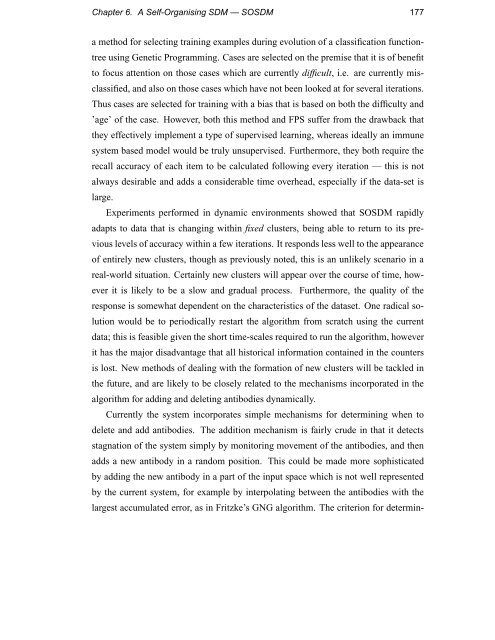Immunology as a Metaphor for Computational ... - Napier University
Immunology as a Metaphor for Computational ... - Napier University
Immunology as a Metaphor for Computational ... - Napier University
You also want an ePaper? Increase the reach of your titles
YUMPU automatically turns print PDFs into web optimized ePapers that Google loves.
Chapter 6. A Self-Organising SDM — SOSDM 177a method <strong>for</strong> selecting training examples during evolution of a cl<strong>as</strong>sification functiontreeusing Genetic Programming. C<strong>as</strong>es are selected on the premise that it is of benefitto focus attention on those c<strong>as</strong>es which are currently difficult, i.e. are currently miscl<strong>as</strong>sified,and also on those c<strong>as</strong>es which have not been looked at <strong>for</strong> several iterations.Thus c<strong>as</strong>es are selected <strong>for</strong> training with a bi<strong>as</strong> that is b<strong>as</strong>ed on both the difficulty and’age’ of the c<strong>as</strong>e. However, both this method and FPS suffer from the drawback thatthey effectively implement a type of supervised learning, where<strong>as</strong> ideally an immunesystem b<strong>as</strong>ed model would be truly unsupervised. Furthermore, they both require therecall accuracy of each item to be calculated following every iteration — this is notalways desirable and adds a considerable time overhead, especially if the data-set islarge.Experiments per<strong>for</strong>med in dynamic environments showed that SOSDM rapidlyadapts to data that is changing within fixed clusters, being able to return to its previouslevels of accuracy within a few iterations. It responds less well to the appearanceof entirely new clusters, though <strong>as</strong> previously noted, this is an unlikely scenario in areal-world situation. Certainly new clusters will appear over the course of time, howeverit is likely to be a slow and gradual process. Furthermore, the quality of theresponse is somewhat dependent on the characteristics of the dat<strong>as</strong>et. One radical solutionwould be to periodically restart the algorithm from scratch using the currentdata; this is fe<strong>as</strong>ible given the short time-scales required to run the algorithm, howeverit h<strong>as</strong> the major disadvantage that all historical in<strong>for</strong>mation contained in the countersis lost. New methods of dealing with the <strong>for</strong>mation of new clusters will be tackled inthe future, and are likely to be closely related to the mechanisms incorporated in thealgorithm <strong>for</strong> adding and deleting antibodies dynamically.Currently the system incorporates simple mechanisms <strong>for</strong> determining when todelete and add antibodies. The addition mechanism is fairly crude in that it detectsstagnation of the system simply by monitoring movement of the antibodies, and thenadds a new antibody in a random position. This could be made more sophisticatedby adding the new antibody in a part of the input space which is not well representedby the current system, <strong>for</strong> example by interpolating between the antibodies with thelargest accumulated error, <strong>as</strong> in Fritzke’s GNG algorithm. The criterion <strong>for</strong> determin-









![Unit 5. Switches and VLANs [PDF]](https://img.yumpu.com/34422504/1/184x260/unit-5-switches-and-vlans-pdf.jpg?quality=85)






